![]()
![]()
![]()
Use LEFT and RIGHT arrow keys to navigate between flashcards;
Use UP and DOWN arrow keys to flip the card;
H to show hint;
A reads text to speech;
39 Cards in this Set
- Front
- Back
|
Which one of the following taxonomic levels would be the most inclusive and thus contain the most diverse assemblage of organisms: genus, order, family, or class? |
Class |
|
|
Which one of the following taxonomic levels would be the least inclusive and thus contain the most diverse assemblage of organisms: genus, order, family, or class? |
genus |
|
|
Would you consider the wings of a moth and the wings of a bird analogous or homologous? Why? |
Moth wings and bird wings are analogous because they do not sharea common evolutionary origin—insects evolved wings separately from birds. |
|
|
would you consider the heart of a chicken and the heart of a fish analogous or homologous? Why? |
Chicken hearts and fish hearts are homologous because they evolved earlier in the common ancestor of chickens and fishes and have been passed down to allother descendants in this evolutionary lineage. |
|
|
The correct sequence from the most to the least inclusive (with regard to numbers of members) of the taxonomic levels is |
domain, kingdom, phylum, class, order, family, genus, and species |
|

List three homologous structures shared by sharks and ray-fined fishes. |
Dorsal nerve cord, paired senseorgans, tripartite brain, jaws, paired appendages |
|
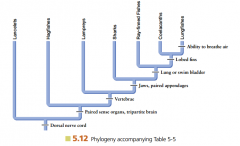
List all traits present in the direct common ancestor of lampreys. |
Vertebrae, paired sense organs, tripartitebrain, and dorsal nerve cord |
|
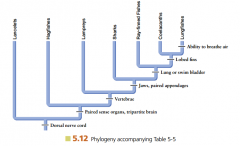
Are these aquatic vertebrates monophyletic, paraphyletic, or polyphyletic? How do youknow? |
Monophyletic, because this grouping of aquatic vertebrates contains all the descendants of a singlecommon ancestor. |
|
|
Which of the following statements about binomial nomenclature is false? a. Both genus and species names are always italicized. b. The name following the genus is referred to as the species epithet. c. Both genus and species names are always capitalized. d. The genus category is more inclusive than the species category. |
c. Both genus and species names are always capitalized. |
|
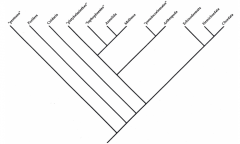
How many terminal taxa are represented in this tree? |
12 |
|
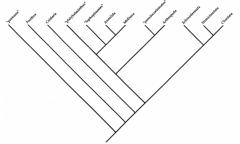
indicate whether it is monophyletic, paraphyletic, or polyphyletic Porifera |
monophyletic |
|
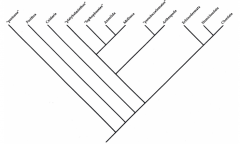
indicate whether it is monophyletic, paraphyletic, or polyphyletic Arthropoda |
monophyletic |
|
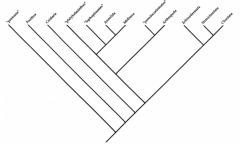
indicate whether it is monophyletic, paraphyletic, or polyphyletic Echinodermata + Hemichordata + Chordata |
monophyletic |
|
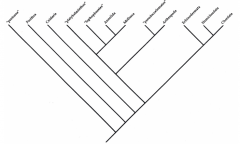
indicate whether it is monophyletic, paraphyletic, or polyphyletic Echinodermata + Hemichordata |
paraphyletic |
|
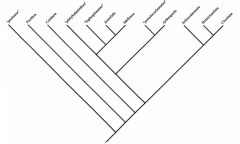
indicate whether it is monophyletic, paraphyletic, or polyphyletic Annelida + Mollusca |
monophyletic |
|

indicate whether it is monophyletic, paraphyletic, or polyphyletic Cnidaria + Mollusca |
polyphyletic |
|
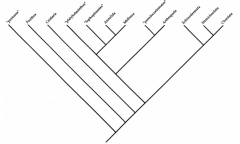
indicate whether it is monophyletic, paraphyletic, or polyphyletic “platyhelminthes” + “lophophorates” + Annelida |
paraphyletic |
|
|
A group that contains descendants from two or more common ancestors is part of a ____________ group. |
polyphyletic |
|
|
If two organisms belong to the same class, they would also belong to the same __________. |
phylum |
|
|
A group that contains an ancestral species and all of its descendants is called a __________ group. |
monophyletic |
|
|
All mammals have backbones but the presence of a backbone does not distinguish mammals from other vertebrates. Backbones would be considered a shared _________ character in mammals. a. derived b. ancestral c. vestigial d. convergent e. cladistic |
b. ancestral |
|
|
Both a tuna fish and a turtle have Hinged jaws. Hinged jaws is an example of in both the tuna and the turtle.Choose one answer.
a. shared ancestral character b. shared derived character c. analogous structures d. homoplasies |
a. shared ancestral character |
|
|
a group that contains an ancestor and some but not all of its descendants is called a ____________ group. |
paraphyletic |
|
|
Which of the taxa would be the most homologous in the organisms it contains? |
Genus |
|
|
f two organisms belong to the same order, they would also have to belong to the same _______. |
class |
|
|
describe the species epithet.
|
second word of a particular species of the genus
|
|
|
how do you write binomial nomenclature |
Genus /species/ |
|
|
describe what the domain Eukarya consists of |
organisms with membrane-enclosed cell organelles |
|
|
what are phylogenetic trees used for? |
to see the order in which lineages split over the course of time |
|
|
which (mono/para/polyphyletic) group can be removed from a tree with a single "cut"? |
monophyletic |
|
|
A group that contains some, but not all the descendants is called a (mono/para/polyphyletic) group |
paraphyletic |
|
|
A group consisting of members that do not share the same common ancestor is reffered to as (mono/para/polyphyletic) group |
polyphyletic |
|
|
give an example of a polyphyletic feature |
wings in bats, birds, and insects |
|
|
what are characters? |
heritable features |
|
|
what is an ancestral character state and what is another word for it? |
sympleisiomorphy; a character that was present in the common ancestor of the entire group |
|
|
what is a derived character state and what is another word for it? |
synamorphy; A character which is derived, and because it is shared by the taxa under consideration, is used to infer common ancestry |
|
|
what is the outgroup? |
a species from an evolutionary lineage that is known to have diverged before the lineage that includes the species that is being studied |
|
|
what are homologous characters? |
similar structure but different function. shared traits in different groups that are similar because they were inherited from a common ancestor. |
|
|
what are analogous characters? |
similar function but different structure. similar structures that have separate evolutionary origins |

